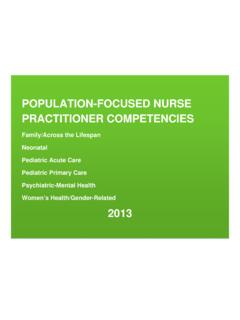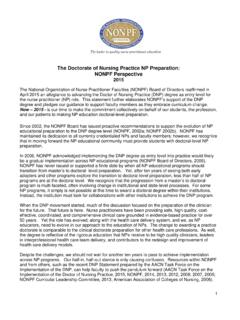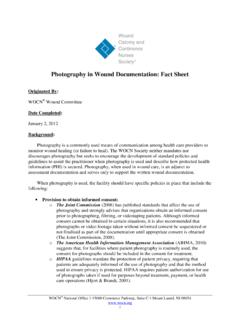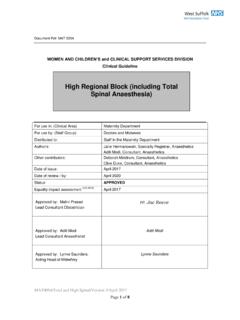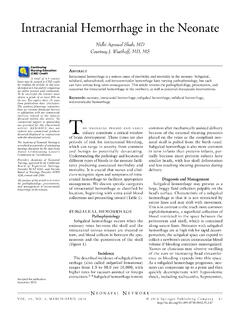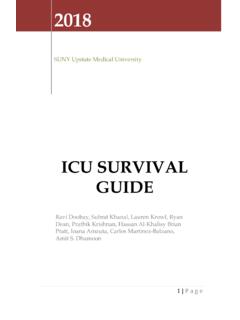Transcription of Pediatric Dermatology: Bumps and Lumps
1 PediatricDermatology: Bumps andLumpsShoni Rozenberg, DO*Suzanne SirotaRozenberg, DO, FAOCD**OGME 3, St John s Episcopal Hospital dermatology Program, Queens, NY**Program Director, St John s Episcopal Hospital dermatology ProgramQueens, NYDisclosure I have no conflicts of interest or financial relationships to disclose. Some medications discussed may be used Overview of common Pediatric cutaneous growths. Identify common skin lesions on Pediatric patients. Understand the current treatment for common Pediatric growths. Discuss availability of new medications and treatment Question 1. Verruca Vulgaris, common warts , found most frequently on hands, feet and fingers are benign epidermal tumors caused by human papillomavirus, specifically HPV types: A.
2 1 B. 6 and 11 C. 16 and 18 D. 2 and 4 Pre-test Question 1. Verruca Vulgaris, common warts , found most frequently on hands, feet and fingers are benign epidermal tumors caused by human papillomavirus, specifically HPV types: A. 1 B. 6 and 11 C. 16 and 18 D. 2 and 4 Differential diagnosis of Lumps and Bumps Congenital Vascular Inflammatory Neoplastic Infectious MalignantCongenital Encephalocele Dermoidcyst Nasal glioma Branchialcleft cyst Thyroglossalduct cyst Accessory tragusDermoidCyst Firm, non-mobile cysts usually noticeable at birth Site of closure of embryonic clefts most common along the eye at the supraorbital ridge and nasal root contains multiple adnexal structures: hair follicles, eccrineglands, sebaceous glands, and apocrine glands.
3 If a pit is present, intracranial extension is more likely Don t squeeze!CT or MRI to r/o encephaloceleor malignant Cyst Small, solitary cyst Midlinein sternal notch Present at birth Abnormal budding of tracheobronchial tree Ddx: milia, cyst, divot, and congenital cartilaginous rest of the neck (wattle) that appears as a firm, exophytic, flesh-colored tag at the midline to lateral neck. As compared to: Thyroglossalduct cyst: midline, upper neck Along thyroid gland. Moves up and down with swallowing. Branchialcleft cyst: lateral, upper neck. Along SCM. HurwitzAccessory Tragus Soft or firm (depending on cartilage), flesh-colored papules anterior to the normal tragus, b/l6% cases benign relatively common finding in newborns Syndromes associated: Oculoauriculovertebralsyndrome (or Goldenharsyndrome) where epibulbardermoidcysts and vertebral defects are TragusHurwitzVascular Hemangiomaof infancy Vascular malformation (venous, AVM, lymphatic) Pyogenic granuloma Spider AngiomaSuperficial Infantile Hemangioma mc tumor in neonatal period Proliferative stage: Significant growth over first few months, bright red, finely lobulated surface Involution.
4 Starts to regress after a year, gray-purple, flattens, fibrofatty-atrophic 30% by 3 years, 50% by 5 years, 70% by 7 years, and 90% by 9 years PHACES, PELVISS uperficial Infantile HemangiomaTreatment Propranolol 2 mg/kg/day divided TID During growth period. Long term studies show no risk of developmental adverse effects or growth impairment at age 4 in ptstreated with at least 6 mosof propranolol (JAAD July 2016) Not associated with psychological problems at age 7. (JAAD July 2017) AE: Hypotension, bradycardia Topical gel forming solution can work for superficial hemangiomas Vasoconstrictor, VGEF Pulsed Dye LaserSuperficial Infantile HemangiomaBologniaPyogenic Granuloma Bright, red papule; lobular proliferation of capillaries Rapidly growing, friable, can ulcerate, bleed Usually secondary to trauma Mcon face and neck in peds Tx: shave excision and electrocautery, silver nitrate ,pulsed dye laser (usually needs repeat treatment), topical timolol Timolol: Initial study in March/April 2014 SPD journal using gel forming solution BID.
5 Great results with clearance after 2-3 mos. Bleeding stopped relatively GranulomaBologniaHurwitzSpider Angioma Small raised bright pink papule with radiating spider-like telangiectasias Blanchable Can occur after injury, sneezing, cough May resolve on own LaserSpider AngiomaInflammatory Granuloma annulare Erythema nodosum Vasculitis AcneGranuloma Annulare Pink to erythematous annular, non-scaling papules that can coalesce into plaques Dorsal hands and feet most common Txdifficult: topical/intralesionalsteroids 50-70% resolve 2 years Ddx: tineacorporis, rheumatoid nodulesGranuloma AnnulareHurwitzNeoplastic Pilomatricoma Juvenile xanthogranuloma Langerhans cell histiocytosis Lipoma Smooth-muscle hamartoma Dermatofibroma Dermatofibrosarcomaprotuberans Infantile digital fibroma of childhood Infantile myofibromatosis Neurofibroma Mastocytosis Angiofibroma Syringoma Eccrineporoma Trichoepithelioma Nevus sebaceus Keratoacanthoma Nevus comedonicus Epidermal nevus Melanocytic nevus Spitz nevus Keloid Epidermoidcyst Steatocystomamultiplex Collagenoma Vellushair cysts OsteomacutisJuvenile Xanthogranuloma(JXG)
6 Yellow to orange papule to nodule, on head or neck Early childhood, 20% present at birth, M>F Classified as a non Langerhaancell histiocytosis, cells derived from dermal dendrocytes. considered a reactive proliferation, but it is unclear what stimulates them. Can have extracutaneousfindings, mc ocular, pts, specifallythe iris. Children under 2 years of age with multiple lesions are more likely to have eye involvement. spontaneous hemorrhage in the anterior chamber of the eye, or hyphema, is the most common ocular presentation. typically treated with intralesionalor systemic corticosteroids, radiation, or surgical Association btwnJXG and NF-1, and juvenile chronic myelogenousleukemia (JCML). Spontaneously resolves in several months to 6 years Residual pigmentaryalteration and atrophy.
7 Treatment is reserved for systemic disease and symptomatic lesions. Corticosteroids, radiation, and surgical Rock-hard, calcified nodule with bluishhue, non-painful Face (mc), head and neck F>M Derived from the hair matrix Multiple lesions have been associated with myotonicdystrophy (Steinertdisease), Gardner syndrome, Rubinstein Taybisyndrome, and trisomy 9. Two useful diagnostic signs are the tent sign and teeter-totter sign Ddx: dermoidcyst, epidermoidcyst Larger and cosmetically unacceptable lesions should be surgically excised, as they are unlikely to regress Smooth-topped, firm, flesh to slightly tan colored papule nasolabialfolds (mc), upper lip, central forehead Multiple lesions are inherited dominantly, AD; Brooke Spiegler. Benign tumors, or possible hamartomas, derived from the pilosebaceousunit.
8 The genetic defect has been mapped to chromosome 9p21. A solitary trichoepitheliomacan be removed by simple excision. Treatment: shave removal, dermabrasion, electrodessication, and Sebaceous of Jadasson Well circumscribed, orange to tan plaque on head or face Usually present at birth PTCH gene mutation Surgical excision has been recommended traditionally out of concern for development of secondary neoplasms: Most common secondary benign neoplasm isSPAP; 1/3 pts Most common secondary malignant neoplasm is BCC Most of them are probably trichoblastomas Multiple nevi sebaceous may occur in association with Schimmelpenningsyndrome: Nevus sebaceous occurs with cerebral, ocular and skeletal Sebaceous of JadassonHurwitzSolitary Mastocytoma Erythematous to tan colored papule or plaque, can blister Birth, first few months of life Benign, collection of mast cells Dariersign Urticarial when rubbed Resolves spontaneously UrticariaPigmentosa Multiple brown macules and plaquesSolitary MastocytomaHurwitzDermatofibroma Small, well-defined reddish-brown dermal nodule Extremities mc ; can be anywhere Benign neoplasm of fibrous connective tissue occasionally seen in children Etiology unknown.
9 Usually secondary to insect bite or folliculitis Dimple sign No treatment necessary Can be excisedDermatofibromaBologniaEpidermal Nevus Linear, warty hyperpigmentedplaque At birth, infancy Benign, hyperplasia of epidermal keratinocytes Commonly on extremities;Blaschkoiddistribution ILVEN (inflammatory linear verrucousepidermal nevus ) Superficial destructive therapies lead to high recurrence rate Tx: Retinoids, 5-FU, steroids, surgical excision are effective for smaller, localize lesions, Cryotherapy, dermabrasion, electrodesiccation, CO2 laser ablation Epidermal Nevus Syndromes: nevi associated with seizures, MR, skeletal and ocular defects. SchimmelpenningSyndrome, Nevus ComedonicusSyndrome, Pigmented hairy cell nevus syndrome, Proteus syndrome, NevusHurwitzInfantile Digital Fibroma Firm, dome shaped nodule on dorsum of fingers and toes < 1yo, M = F spontaneous regression 2-3 yrs Observe, if large can resect high recurrence rateInfantile Digital FibromaBologniaVellusHair Cysts multiple, 1 2 mm diameter, follicular papules axillae, neck, chest, abdomen, and arm flexures asymptomatic lesions resolve over months to years without treatment familial cases with AD inheritance have been described topical retinoidsmay hasten the resolution, but can be CystsBologniaSteatocystoma Single or multiple firm, round, cystic nodules Chest, arms and face KRT17 gene Tx.
10 Excisonfor simple cysts Isotretinoincan shrink existing nodules and can temporarily prevent new lesions. SteatocystomaBologniaSyringoma Small, flesh to yellow colored papules eyelidsare most common, neck, torso, extremities, genitalia Single or multiple Benign tumors of eccrineglands Present at puberty Tx: cryosurgery, dessication, CO2 laserSyringomaHurwitzCohenAngiofibroma red, firm, blanchablepapules Usually solitary If multiple lesions on the face may be associated with: Tuberous Sclerosis: scalp, cheeks, nlfs MEN-1 appear in early childhoodAngiofibromaNeurofibroma Soft, flesh-colored, compressible papule Buttonhole sign Benign, neural origin Sporadic in healthy individuals Multiple plexiformtype neurofibromasass with: Neurofibromatosis type 1 NeurofibromaInfectious Wart MolluscumContagiosum Nodular Scabies Insect Bite Cat Scratch Disease Deep Fungal Infection Orf PapularUrticariaWarts Verrucouspapules; mc fingers, hands and feet Benign, caused by HPV Incubation period: 1-3 months to years.




